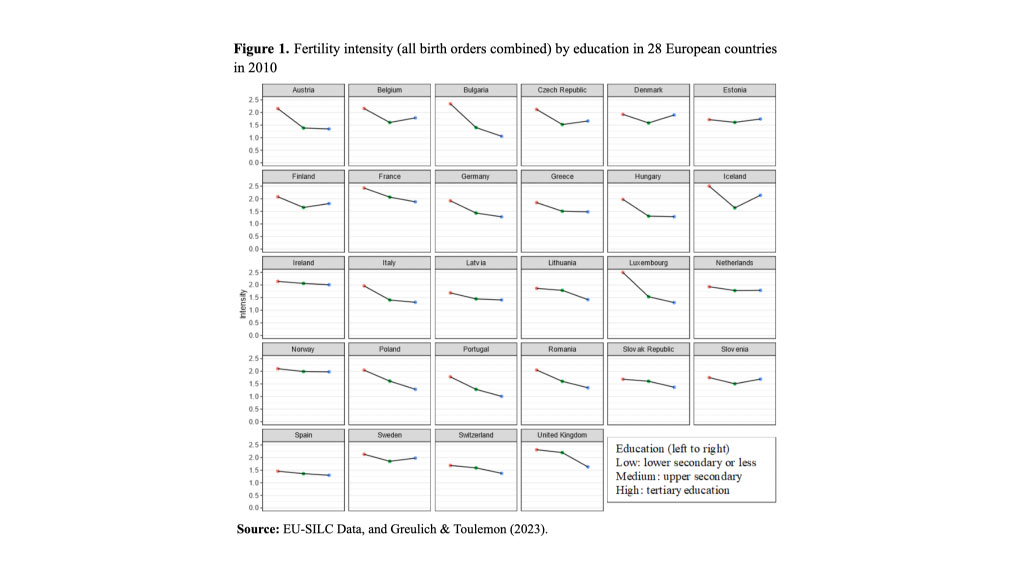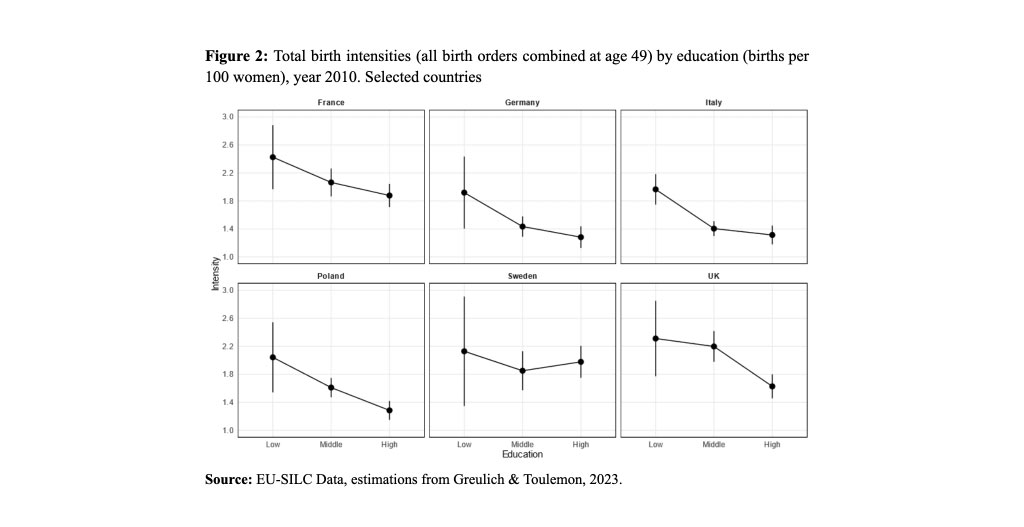Angela Greulich and Laurent Toulemon present a new method for measuring the educational gradient of fertility for women who are at childbearing age rather than for women who have already completed their reproductive years, enabling a timely analysis of within-country differentials of period fertility behavior.
Introduction
After a period of increase during the decades 1990-2010, fertility is currently stagnating or decreasing in many European countries. As its levels and trends have multiple social and economic impacts, understanding their drivers at the micro level is of paramount importance. However, while European cross-country differences in total fertility rates (TFR) are well-documented, a comprehensive overview of within-country differentials is currently lacking. Measures of fertility differentiated by education have so far been mostly based on a completed cohort approach, and they show a negative educational gradient in most European countries (Sobotka 2020, Nisén et al. 2021). This implies that it was mainly higher educated women who were deciding to limit their fertility 10 to 20 years ago in Europe, mostly due to incompatibilities between work and family. The focus, in other words, is on cohorts whose fertility decisions were affected by past, not current, circumstances and policies.
Furthermore, as studies on socioeconomic differentials of period fertility behavior are often parity-specific (see for example Klesment et al. 2014, d’Albis et al. 2017, Trimarchi and van Bavel 2019), we do not know exactly which subgroups currently have the lowest fertility levels within European countries, and to what extent these subgroups contribute to the dampening of total fertility rates in each country.
Fertility by age, parity and education using UE-SILC Data
In a recent publication (Greulich and Toulemon 2023), we proposed a new method of exploiting annual European survey data to accurately measure period fertility levels by education for 24 EU and four non-EU countries in Europe. Our data are those of the European Union Survey of Income and Living Conditions, EU-SILC (available on the Eurostat website; Eurostat 2020), based on large national individual samples, collected on a yearly basis, with a four-year follow-up. Respondents are not asked directly about their fertility in the questionnaire, but it can be estimated by combining the own-children method (children ever born at age 25) with a semi-retrospective approach to derive the parity-specific fertility behavior of women of higher childbearing ages (De Santis et al. 2014), while at the same time recording their educational level. Bayesian statistics allow us to obtain credible intervals for the age-, education- and parity-specific birth probabilities for each country. These birth probabilities are then combined into a multi-state life table to obtain parity-specific and total birth intensities by education. We use post-stratification of birth probabilities to calibrate our estimates with national total fertility rates, enabling international comparisons for specific groups (e.g. highly educated women) or for particular dimensions of fertility behavior (e.g. childlessness).
Our estimates refer to the year 2010, which makes our educational gradients of period fertility levels comparable with those based on census data, allowing for additional data quality checks.
Main results for 2010
Even though low educated women have the highest period fertility levels in almost all European countries, the educational gradient is not universally negative. In 2010, period fertility levels exhibited a U-shaped pattern in a third of European countries, with medium-educated women having the lowest fertility.
Highly educated women have considerably higher fertility levels than medium-educated women in the Nordic countries (Iceland and Denmark, followed by Sweden and Finland) but also in Belgium, the Czech Republic and Slovenia. Conversely, the educational gradient is strongly negative in Portugal, Bulgaria, Luxembourg, Poland and Romania.
The remarkable diversity in period fertility levels among highly educated women in Europe is due to higher transitions to first and second childbirth among this group in some countries than in others; higher order births, on the other hand, exhibit a universally negative educational gradient (Fig. 1).

Focusing on six countries
Figure 2 illustrates the diversity of European period fertility levels for six selected countries that can be considered representative of a specific European region:
• France, for the Continental countries including Belgium, the Netherlands and Luxembourg,
• Germany, for the German-speaking countries including Austria and Switzerland,
• Italy, for the Mediterranean countries,
• Poland, for the Central and Eastern European countries,
• Sweden, for the Nordic countries and
• the UK, for the English-speaking countries including Ireland.

In all six countries, birth intensities are highest for the low educated. Germany, Italy and Poland, all with TFR <1.5, show a strong negative educational gradient: medium and highly educated women have a much lower fertility level than low educated women. Conversely, France, the UK and Sweden have comparatively high fertility levels for medium and highly educated women, although France and the UK still show a negative educational gradient. In Sweden, there is no clear educational gradient, and the fertility differences between educational groups are not significant.
Relatively high period fertility levels for medium and highly educated women combine with a higher proportion of highly educated women in Sweden, France and the UK (about 50% in our sample) than in Germany, Poland and Italy (less than 40%), which results in comparatively higher fertility (above 1.5 children per woman) in the former group of countries.
Checking, documenting and disseminating data and results
The cross-sectional database of the EU-SILC, on which our measures are built, includes datasets since 2004 for most countries.
We are currently producing the full set of data by year (2004-22), age, parity, education and country, using R software, and checking our data with external data sources, such as population censuses and civil registers (more information is available in the appendix of our 2023 paper, e.g. fertility by age, parity, level of education, summary data for 2005 and 2015, as well as STATA and Excel documents presenting our method). In addition to research papers, we will document our data and methods on a website, and disseminate them on other web platforms, including the Human Fertility Database and the Human Fertility Collection. A growing number of datasets are becoming available, but their accuracy and relevance needs to be assessed. It is important to share methods and documentation to take advantage of these new possibilities.
References
d’Albis H., Gobbi P., Greulich A. (2017). Having a Second Child and Access to Childcare: Evidence from European Countries. Journal of Demographic Economics 83(02): 177–210.
De Santis G., Drefahl S., Vignoli D. (2014). A Period Total Fertility Rate with Covariates for Short-Panel Data. Population 69 (3): 419–432.
Eurostat (2020). EU statistics on income and living conditions microdata.
Greulich A., Toulemon L. (2023). Measuring the educational gradient of period fertility in 28 European countries: A new approach based on parity-specific fertility estimates. Demographic Research 49(34): 905–968.
Klesment M., Puur A., Rahnu L., Sakkeus L. (2014). Varying association between education and second births in Europe: Comparative analysis based on the EU-SILC data. Demographic Research 31(1): 813–860.
Nisén J., Klüsener S., Dahlberg J, Dommermuth L, Jasilioniene A., Kreyenfeld M., Lappegård T., Li P., Martikainen P., Neels K., Riederer B., Riele S., Szabó L., Trimarchi A., Viciana F., Wilson B., Myrskylä M. (2021). Educational Differences in Cohort Fertility Across Sub-national Regions in Europe. European Journal of Population 37: 263–295.
Sobotka, T. (2020). Fertility Across Time and Space. Data and Research Advances. Vienna Yearbook of Population Research 18: 1–24.
Trimarchi A., Van Bavel J. (2019). Partners’ Educational Characteristics and Fertility: Disentangling the Effects of Earning Potential and Unemployment Risk on Second Births. European Journal of Population 36(3): 439–464.


